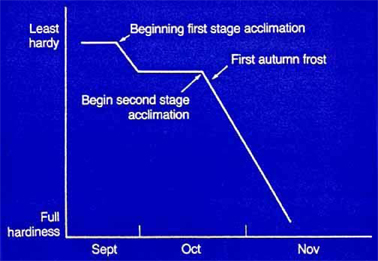Points to ponder as you prepare nursery plants for winter protection
Hardening plants or providing dormancy requires many conditions to occur all at the same time within the plant.
Editor’s note: This article is from the archives of the MSU Crop Advisory Team Alerts. Check the label of any pesticide referenced to ensure your use is included.
Hardening plants or providing dormancy requires many conditions to occur all at the same time within the plant. Nursery practices like fertilizer applications, irrigation, pruning and light levels all contribute to how successful plants will overwinter and avoid winter injury.
Plants that have a balanced nutrient content overwinter better. Avoid fertilizing plants about six weeks before the average first frost date for your area. Be sure you choose the correct controlled release fertilizer so your plants have lower nutrient levels in the pots over the winter. Research has shown plants prefer higher potassium (K) levels going into the winter. High K promotes cell permeability that is important in avoiding cellular freeze injury. A foliar level of 50 to 75 ppm K is generally sufficient. Field grown plants having soil test levels above 50 lbs./A. is adequate.
Overwintered plants require moisture so be sure to provide enough water to allows some moisture to reach the bottom of the container. Check field stock for moisture availability because a dry September can cause fertilizer that was applied earlier to release when rains do occur causing a flush of new growth. Overwintered nursery stock survival is directly correlated with reduced energy storage due to dry root balls. Dry plants in the fall may not have enough root reserve to break bud and shoot expansion in the spring.
Avoid late season pruning, which may stimulate bud break that ends up causing new growth that is not hardened off. Pruning like fertilization should stop six weeks before the first frost date.
When temperatures begin to drop, most plants slow their growth and begin the winter hardening process which ends up as dormancy. Figure 1 shows this process.
Light levels decrease in the fall, and shorter day lengths signal to the plants that dormancy is starting to occur. Shaded plants acclimate more slowly than those in the sun do. That is another reason for removing shade cloth in the fall.
Be sure to apply protective fungicides to plants being protected for overwintering. A fungicide drench for Pythium or Phytopthora is suggested. Also, a foliar fungicide application is suggested to protect any cut stems, branches or wounds during the hardening off process. If herbicides are used, be sure a safe amount of time has elapsed between application and the covering of poly houses to avoid crop injury.



 Print
Print Email
Email


